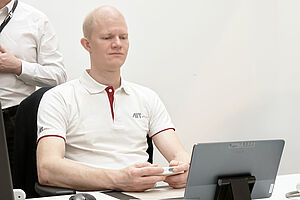High blood pressure, also known as arterial hypertension, is a widespread health problem in Austria. Around a quarter of the population suffers from high blood pressure - that's around two million people - and many don't even realise it. In older age, one in two people are even affected. The increase in high blood pressure among young people is also worrying: studies by MedUni Vienna show that one in five male adolescents already suffers from hypertension, which can be attributed to a lack of exercise, an unhealthy diet and stress. Untreated high blood pressure can have serious consequences such as heart attacks, strokes and kidney failure, which is why regular and simple monitoring is essential.
Building on many years of experience and in-depth research into pulse wave analysis, the Medical Signal Analysis Team at the AIT Centre for Health and Bioresources is now developing a compact blood pressure monitor in the DigiPIT project that does not require a cuff and still meets the highest medical requirements.
Innovative technology through pulse wave analysis
The new AIT device uses the proven method of oscillometric measurement, known from conventional automatic blood pressure monitors with an upper arm cuff, to accurately determine blood pressure. However, instead of the bulky cuff with pumps and valves, a tiny light sensor with an integrated force sensor is used to measure pressure, which records the arterial pulse waves. As a result, the prototype is barely larger than a mascara pen and enables the precise recording of vital parameters within seconds: Users simply place their index finger on the device and steadily increase the pressure for 30 to 40 seconds. An algorithm then reliably calculates the systolic and diastolic blood pressure values - comparable in accuracy to medical cuff devices.
FH Wiener Neustadt optimises user-friendliness
While the technological development and pulse wave analysis expertise lies with AIT, the University of Applied Sciences Wiener Neustadt (FHWN) has contributed its expertise in comprehensive usability studies. This enabled the handling of the innovative measuring device to be optimised and adapted to everyday usage scenarios. The FHWN analysed the device for accuracy and user-friendliness in a series of three studies at the City Campus.
ORF reports in detail on the DigiPIT project in the ORF-NÖ Heute programme: ‘Why actually measure blood pressure?’ (German):





